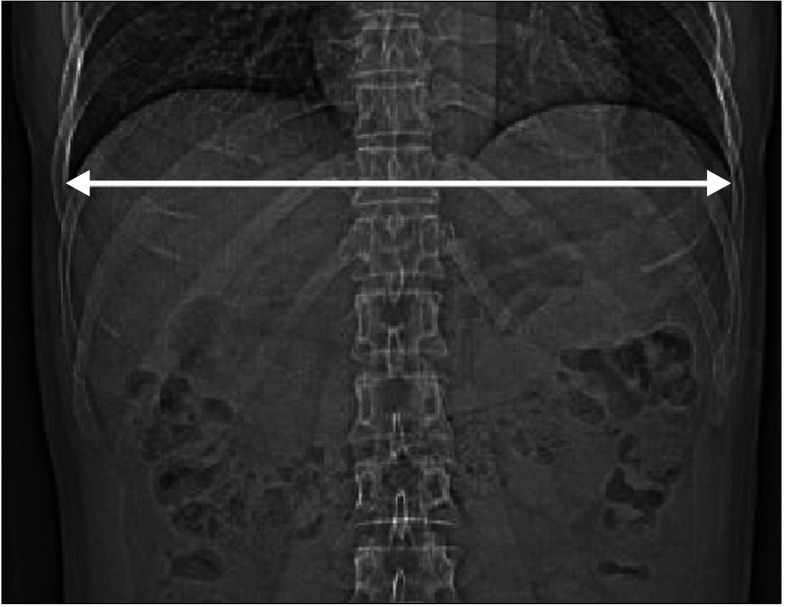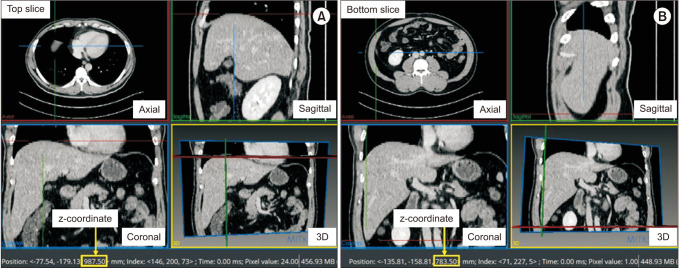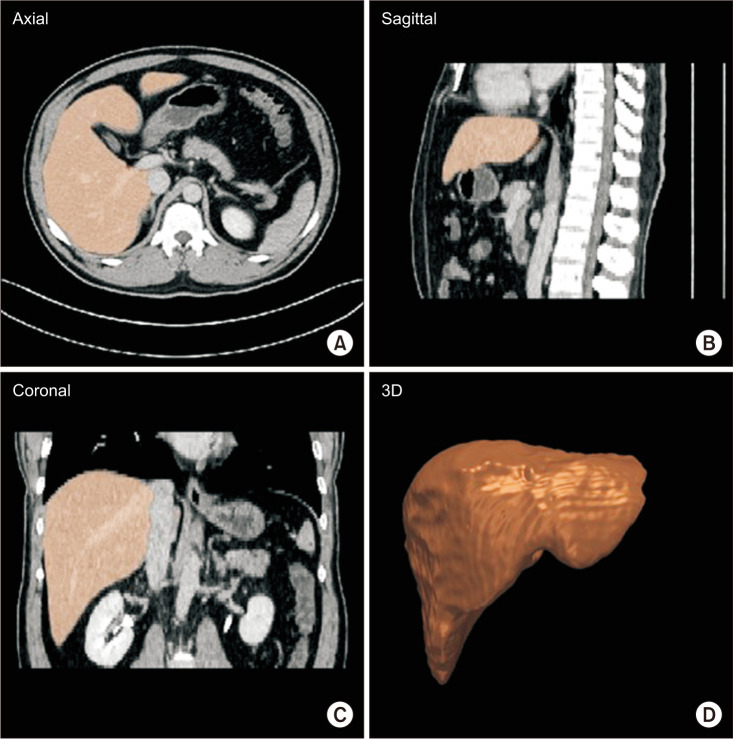Ann Surg Treat Res.
2022 Jul;103(1):47-52. 10.4174/astr.2022.103.1.47.
A new formula for estimation of standard liver volume using liver height and thoracic width
- Affiliations
-
- 1School of Global Entrepreneurship and Information Communication Technology, Handong Global University, Pohang, Korea
- 2Department of Surgery, Jeonbuk National University Medical School, Jeonju, Korea
- 3Biomedical Research Institute, Jeonbuk National University Hospital, Jeonju, Korea
- 4Research Institute of Clinical Medicine of Jeonbuk National University, Jeonju, Korea
- KMID: 2531147
- DOI: http://doi.org/10.4174/astr.2022.103.1.47
Abstract
- Purpose
Precise estimation of the standard liver volume (SLV) is crucial in decision making regarding major hepatectomy and living donor liver transplantation. This study aimed to propose an accurate and efficient formula for estimating the SLV in the Korean population.
Methods
We created a regression model for SLV estimation using a data set of 230 Korean patients with healthy livers. The proposed model was cross validated using a different data set of 37 patients with healthy livers. The total liver volume (TLV), except for the volume of liver blood vessels, was measured through computed tomography volumetry as the dependent variable. Various anthropometric variables, liver height (LH), thoracic width (TW), age, and sex (0, female and 1, male) were considered as candidates for independent variables. We conducted stepwise regression analysis to identify variables to be included in the proposed model.
Results
A new formula was established; SLV = −1,275 + 9.85 × body weight (BW, kg) + 19.95 × TW (cm) + 7.401 × LH (mm). The proposed formula showed the best performance among existing formulas over the cross-validation data set.
Conclusion
The proposed formula derived using BW, TW, and LH estimated the TLV in the cross-validation data set more accurately than existing formulas.f
Keyword
Figure
Reference
-
1. Lo CM, Fan ST, Liu CL, Chan JK, Lam BK, Lau GK, et al. Minimum graft size for successful living donor liver transplantation. Transplantation. 1999; 68:1112–1116. PMID: 10551638.
Article2. Chen CL, Fan ST, Lee SG, Makuuchi M, Tanaka K. Living-donor liver transplantation: 12 years of experience in Asia. Transplantation. 2003; 75(3 Suppl):S6–S11. PMID: 12589130.
Article3. Kawasaki S, Makuuchi M, Matsunami H, Hashikura Y, Ikegami T, Nakazawa Y, et al. Living related liver transplantation in adults. Ann Surg. 1998; 227:269–274. PMID: 9488526.
Article4. Kiuchi T, Kasahara M, Uryuhara K, Inomata Y, Uemoto S, Asonuma K, et al. Impact of graft size mismatching on graft prognosis in liver transplantation from living donors. Transplantation. 1999; 67:321–327. PMID: 10075602.
Article5. Sugawara Y, Makuuchi M, Takayama T, Imamura H, Dowaki S, Mizuta K, et al. Small-for-size grafts in living-related liver transplantation. J Am Coll Surg. 2001; 192:510–513. PMID: 11294408.
Article6. Inomata Y, Kiuchi T, Kim I, Uemoto S, Egawa H, Asonuma K, et al. Auxiliary partial orthotopic living donor liver transplantation as an aid for small-for-size grafts in larger recipients. Transplantation. 1999; 67:1314–1319. PMID: 10360583.
Article7. Ben-Haim M, Emre S, Fishbein TM, Sheiner PA, Bodian CA, Kim-Schluger L, et al. Critical graft size in adult-to-adult living donor liver transplantation: impact of the recipient’s disease. Liver Transpl. 2001; 7:948–953. PMID: 11699030.
Article8. Heaton N. Small-for-size liver syndrome after auxiliary and split liver transplantation: donor selection. Liver Transpl. 2003; 9:S26–S28. PMID: 12942475.
Article9. Sakamoto S, Uemoto S, Uryuhara K, Kim Id, Kiuchi T, Egawa H, et al. Graft size assessment and analysis of donors for living donor liver transplantation using right lobe. Transplantation. 2001; 71:1407–1413. PMID: 11391227.
Article10. Nishizaki T, Ikegami T, Hiroshige S, Hashimoto K, Uchiyama H, Yoshizumi T, et al. Small graft for living donor liver transplantation. Ann Surg. 2001; 233:575–580. PMID: 11303141.
Article11. Kiuchi T, Tanaka K, Ito T, Oike F, Ogura Y, Fujimoto Y, et al. Small-for-size graft in living donor liver transplantation: how far should we go? Liver Transpl. 2003; 9:S29–S35.
Article12. Heinemann A, Wischhusen F, Püschel K, Rogiers X. Standard liver volume in the Caucasian population. Liver Transpl Surg. 1999; 5:366–368. PMID: 10477836.
Article13. Yu HC, You H, Lee H, Jin ZW, Moon JI, Cho BH. Estimation of standard liver volume for liver transplantation in the Korean population. Liver Transpl. 2004; 10:779–783. PMID: 15162473.
Article14. Vauthey JN, Abdalla EK, Doherty DA, Gertsch P, Fenstermacher MJ, Loyer EM, et al. Body surface area and body weight predict total liver volume in Western adults. Liver Transpl. 2002; 8:233–240. PMID: 11910568.
Article15. Poovathumkadavil A, Leung KF, Al Ghamdi HM, Othman Iel H, Meshikhes AW. Standard formula for liver volume in Middle Eastern Arabic adults. Transplant Proc. 2010; 42:3600–3605. PMID: 21094823.
Article16. Yuan D, Lu T, Wei YG, Li B, Yan LN, Zeng Y, et al. Estimation of standard liver volume for liver transplantation in the Chinese population. Transplant Proc. 2008; 40:3536–3540. PMID: 19100432.
Article17. Hashimoto T, Makuuchi M. Transplantation: Liver steatosis and errors in estimation of standard liver volume. Nat Rev Gastroenterol Hepatol. 2011; 8:667–668. PMID: 22083115.
Article18. Urata K, Kawasaki S, Matsunami H, Hashikura Y, Ikegami T, Ishizone S, et al. Calculation of child and adult standard liver volume for liver transplantation. Hepatology. 1995; 21:1317–1321. PMID: 7737637.
Article19. Fu-Gui L, Lu-Nan Y, Bo L, Yong Z, Tian-Fu W, Ming-Qing X, et al. Estimation of standard liver volume in Chinese adult living donors. Transplant Proc. 2009; 41:4052–4056. PMID: 20005340.
Article20. Um EH, Hwang S, Song GW, Jung DH, Ahn CS, Kim KH, et al. Calculation of standard liver volume in Korean adults with analysis of confounding variables. Korean J Hepatobiliary Pancreat Surg. 2015; 19:133–138. PMID: 26693231.
Article21. Yang X, Yang JD, Lee S, Hwang HP, Ahn S, Yu HC, et al. Estimation of standard liver volume using CT volume, body composition, and abdominal geometry measurements. Yonsei Med J. 2018; 59:546–553. PMID: 29749138.
Article22. Kokudo T, Hasegawa K, Uldry E, Matsuyama Y, Kaneko J, Akamatsu N, et al. A new formula for calculating standard liver volume for living donor liver transplantation without using body weight. J Hepatol. 2015; 63:848–854. PMID: 26057995.
Article23. Du Bois D, Du Bois EF. A formula to estimate the approximate surface area if height and weight be known. 1916. Nutrition. 1989; 5:303–313. PMID: 2520314.24. Nolden M, Zelzer S, Seitel A, Wald D, Müller M, Franz AM, et al. The Medical Imaging Interaction Toolkit: challenges and advances: 10 years of open-source development. Int J Comput Assist Radiol Surg. 2013; 8:607–620. PMID: 23588509.
- Full Text Links
- Actions
-
Cited
- CITED
-
- Close
- Share
- Similar articles
-
- A new formula for estimation of standard liver volume using liver height and thoracic width
- Comparison of skeletal muscle index and body surface area-based formulae for estimation of standard liver volume
- Calculation of standard liver volume in Korean adults with analysis of confounding variables
- Comparison of skeletal muscle index-based formula and body surface area-based formula for calculating standard liver volume
- Estimation of Standard Liver Volume Using CT Volume, Body Composition, and Abdominal Geometry Measurements




